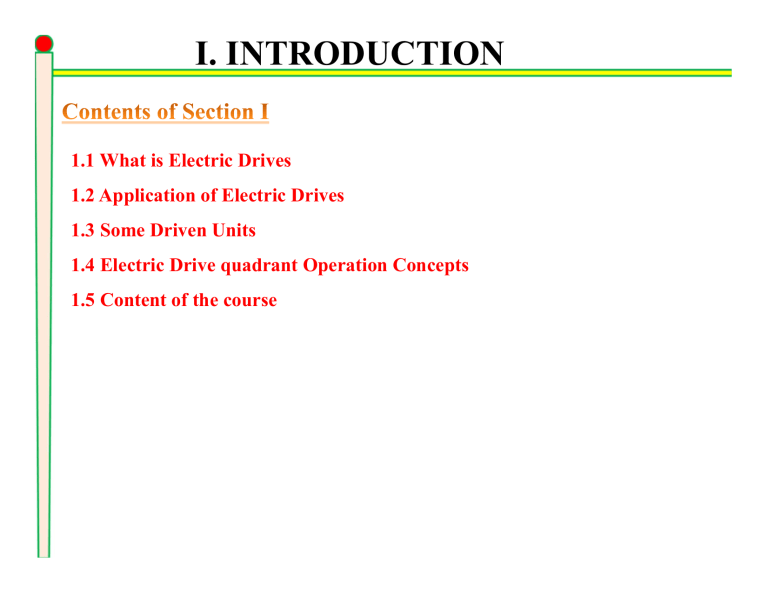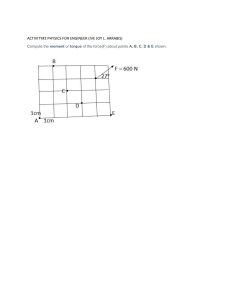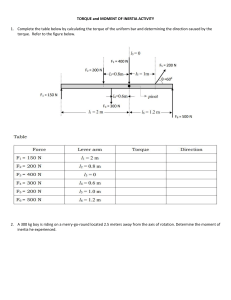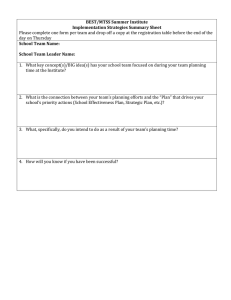
I. INTRODUCTION 1.1 What is Electric Drives 1.2 Application of Electric Drives 1.3 Some Driven Units 1.4 Electric Drive quadrant Operation Concepts 1.5 Content of the course I. INTRODUCTION 1.1 What is Electric Drives Electric Drives Refers to system which converts electrical power to Mechanical power in a Controlled Manner. Such systems consists of:In Traditional Drives: In Modern Electric Drives • Electric motors, • Coupling between the motor and the driven unit like gears, belt and chains, • Electric power supply control systems like Magnetic Contactors, pole changing mechanisms, etc • Electric motors and the • Power Electronics (As Power Processors) and • Control systems. I. INTRODUCTION 1.1 What is Electric Drives The following is a typical block diagram of Modern Electric Drives. There is Electric Motor from which information like motor speed, rotor position, current etc are fed back to controller. The controller based on the command (reference variable) and the feedback variables generate control signal to power electronics systems like (inverter or converter) to control the electric power flow to the the electric motor. I. INTRODUCTION 1.1 What is Electric Drives As indicated in the block diagram, the knowledge and skills required for electric drive design and analysis includes, but not limited to, the following:• Electric Machinery • Power Electronics • Control Theory • Computer including microprocessors and algorithms • Mechanical Systems understanding and modeling • Sensors (instrumentations) • Electric Utility interaction, etc. I. INTRODUCTION 1.1 What is Electric Drives Electric Drives can be DC drives or AC drives. DC drives are equipped with DC motors and AC/DC or DC/DC converters. On the other hand AC drives are equipped with either synchronous motors or induction motors being supplied from inverters. Typical structure of DC motors Typical structure of Induction motors I. INTRODUCTION 1.1 What is Electric Drives In Modern Electric Drives AC drives are encouraged against DC derives. This is due to the following reasons. (1) DC motors require maintenance, are heavy, are expensive, speed limited by mechanical construction (2) AC motors require less maintenance, relatively light, are cheaper, are robust, can run at high speed (esp. squirrel–cage type) With respect to Control unit: For DC drives: Simple control – decoupling torque and flux by mechanical commentator –brush action, the controller can be implemented using simple analog circuit even for high performance torque control –cheaper. For AC drives: The types of controllers to be used depend on the required drive performance –cost increases with performance. Scalar control drives technique does not require fast processor/DSP whereas in Field Oriented Control or Direct Torque Control drives, DSPs or fast processors are normally employed. I. INTRODUCTION 1.2 Application of Electric Drives Today, electric drives application is everywhere; in residential and commercial buildings, in our offices, in various industries including manufacturing, agricultural, transport, etc industries. • Heating, Ventilating and Air Conditioning:- blowers, fans, and compressors • Moving and Mixing process components:- Agitators, pumps, fans, and compressors • As propellers in Transportation:- elevators, trains, and automobiles • Paper and Steel Industry:- hoisting and roller machine derives, winches, chippers, drill presses, sanders, saws, extruders, feeders, mills, and press machining • Oil, Gas, and Mining:- Conveyers, compressors, pumps, cranes, and shovels • Textile:- looms, E.t.c. I. INTRODUCTION 1.3 Some Driven Units Electric drives are basically to derive some mechanical driven units. The driven units can be simple machines to complex systems. Based on their torque-speed characteristics, simple driven units can be categorized in to four. Basic torque-speed characteristics of simple Driven Units can be expressed by the following equation. Where:- TL T f Tn T f n x TL is torque the driven unit exerts on the motor driving it in N-m when the driven unit is running at speed . Tf is frictional torque of the driven unit in N-m, Tn torque the driven unit exert on the motor driving it at its rated operating speed, n, and power. Speed n is rated speed in radians per second. I. INTRODUCTION 1.3 Some Driven Units Driven units can be categorized into four depending on the value of exponent x of the equation. Category 1: x = 0, torque independent of speed. Category 2: x = 1, torque proportional to speed. Category 3: x = 2, torque proportional to speed squared. Category 4: x = -1, torque inversely proportional to speed. I. INTRODUCTION 1.3 Some Driven Units Category 1: x = 0, torque independent of speed. Examples:‐ Crane lifting load at constant speed, conveyer with constant rate of material moved. I. INTRODUCTION 1.3 Some Driven Units Category 2: x=1, torque proportional to speed. Examples:‐ Electric generator with resistive load I. INTRODUCTION 1.3 Some Driven Units Category 3: x=2, torque proportional to speed squared. Examples:- Fans and centrifugal pumps I. INTRODUCTION 1.3 Some Driven Units Category 4: x=-1, torque inversely proportional to speed. Examples:- Drilling machines, metal cutting spindle drives I. INTRODUCTION 1.3 Some Driven Units Some Driven units have combination of these characteristics. Example is an electric driven train has force components which is independent of speed, proportional to speed, proportional to speed squared, … Accelerating force is constant or independent of speed, force required to overcame rail gradient is also independent of speed while, friction and aerodynamic resistance is proportional to speed and speed squared. MgC4 TL rMa rMg sin C1 C2v C3v r R 2 Exercise: Explain each of the above components using physical laws. I. INTRODUCTION 1.4 Electric Drive quadrant Operation Concepts Some of the driven units require operation of the electric drive in various quadrants. Four quadrants are possible on speed versus torque plane. The first quadrant is where the torque and speed are positive and known as forward motoring operation. The second quadrant is where the torque is positive while the speed is negative. This is breaking mode of operation and is known as reverse braking. The third quadrant is where both speed and torque are negative and is known as reverse motoring. The last, fourth, quadrant is forward braking mode of operation where speed is positive while torque is negative. In the two motoring modes of operation, electric power is converted to mechanical power while the reverse is true for the braking modes of operation. Electric drives which can operate in the four quadrants are sometimes known as Ward Leonard Systems. I. INTRODUCTION 1.4 Electric Drive quadrant Operation Concepts Example 1: Crane operation An example of driven unit requiring operation in multiple quadrants is a crane. A crane speed and torque can be considered as positive when it is lifting the load. During this time, electric energy is converted to potential energy. The motor drive is operating in first quadrant. When the crane is to put down the load, the speed becomes negative while the torque has to remain positive in order to prevent the load from acceleration due to gravity. So, the motor is operating in reverse braking mode as shown below. I. INTRODUCTION 1.4 Electric Drive quadrant Operation Concepts Example 2: Electric Vehicle Drive In an electric vehicle drive, the electric drives are required to operate in four quadrants. The first quadrant is when the electric vehicle moves forward bring propelled by the motor. This operation can be considered as first quadrant torque and speed being positive. • If we intend to stop the vehicle, we apply a negative torque decelerating the motor speed. Then we are operating in the fourth quadrant. • The electric vehicle can also move backward with negative speed and torque, that is • third quadrant. Again while the vehicle is moving backward, we may need to apply braking which is positive torque while the speed remains negative. That is reverse breaking, quadrantII operation. I. INTRODUCTION 1.5 Content of the Course In this course we will cover the following main sections II. Electromechanical Energy Conversion Principles III. Basic Electric Machine Models IV. DC motor Drives V. Reference Frame Theory VI. Induction Machine Drives VII. Synchronous Machine Drives



